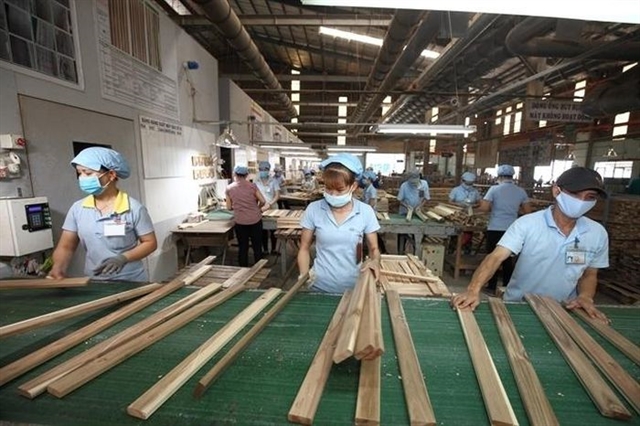 Economy
Economy


|
| About 46 per cent of wood processing enterprises said they would not change their revenue target for this year. Photo dangcongsan.vn |
By Tố Như & Hoàng Hà
HÀ NỘI — The wood processing industry has seen a recovery in production after the fourth outbreak of COVID-19, thanks to the Government's supportive policies.
To support economic recovery, the National Assembly and Government have issued many policies to help enterprises and businesses resume production and business activities.
These policies have included a delay on tax payments, reducing corporate income tax; dropping loan interest rates and financial support for employees. These actions have created a favourable business environment for enterprises of wood production, processing and export.
The government’s highly-anticipated Resolution No 128, on the adoption of provisional guidelines on safe and flexible living with COVID-19, has supported the domestic economy in recovery.
The wood processing industry has built specific strategies and plans to restore production and business in the new normal, according to the Ministry of Agriculture and Rural Development.
Lê Quốc Doanh, Deputy Minister of Agriculture and Rural Development, said that the ministry continues to receive recommendations from enterprises and associations in the wood processing industry to solve difficulties in processing and exporting timber and wooden products.
According to Đỗ Xuân Lập, chairman of the Việt Nam Timber and Forest Products Association (VIFORES), the COVID-19 outbreak has affected the trading of goods, including timber and wooden products. It also hit wood processing centres such as HCM City, Bình Dương, Đồng Nai and Tây Ninh, affecting the wood processing industry’s development.
Now, the pandemic is gradually being controlled, wood processing and export centres are recovering production. Enterprises processing and exporting wooden products have stabilised production faster than expected, especially enterprises applying the 'three on-site' model with on-site production, on-site dining, on-site rest.
“This is a very positive signal for the industry,” said Lập.
Nguyễn Chánh Phương, Vice Chairman of the Handicraft and Wood Industry Association of HCM City (HAWA), said 80 per cent of HAWA member enterprises have restored manufacturing and can deliver goods as scheduled.
Tô Xuân Phúc, an expert from Forest Trend, said that according to a recent survey, only 8.3 per cent of wooden product processing enterprises stopped operations due to the COVID-19. The rest of them had applied different forms to maintain operations; 24 per cent applied the 'three on-site' model.
The pandemic has also caused the number of employees at the surveyed enterprises to decrease by 18 per cent.
Meanwhile, 83 per cent of wood processing enterprises said that they have made recovery plans, according to the survey conducted by the VIFORES, HAWA, the Forest Product Association of Bình Định, the Bình Dương Furniture Association and Forest Trends.
The enterprises with recovery plans said they would change their business strategies, apply pandemic control measures in production and improve efficiency and scale in processing wooden products, Phúc said.
However, Phúc feels that production recovery will also depend on vaccination and the efficiency of pandemic prevention and control measures in production.
About 46 per cent of enterprises said they would not change their targeted revenue for this year, while 37 per cent expected their revenue to increase. The maintaining enterprises predicted their revenue will decrease.
Growth scenario
The VIFORES has two growth scenarios for the rest of the year. In the first scenario, if the industry’s export value of timber and wooden products recovers in the fourth quarter, the total export value in 2021 will reach US$13.6 billion.
In the second, worse, scenario, if the value continues to decline through the fourth quarter, export value will be $12.7 billion for the whole year.
Doanh said the ministry will support enterprises in maintaining traditional export markets but will also expand export markets for wooden products.
According to the General Department of Customs, the export of timber and wooden products in the first ten months of this year reached $12.1 billion, up 23.4 per cent year on year. Major export markets of those products included the US, China and Japan.
HAWA chairman Phương expected that by the end of the year, export turnover will be back to pre-pandemic levels, meaning that value for this year would exceed $14.5 billion, an increase of 15 per cent compared to 2020.
This growth is due to the advantages of free trade agreements (FTAs) Việt Nam has signed, such as EU-Việt Nam FTA (EVFTA) and the Comprehensive and Progressive Agreement for Trans-Pacific Partnership (CPTPP), which increase production capacity of enterprises, he said.
However, input materials and labour are two of the most important factors at present affecting production recovery.
Nguyễn Minh Nhật, director of the Nhất Nam Construction Mechanical Plywood Co, Ltd, said that his company has nearly four months of production under the 'three on-site' model, which maintained employment for about 60 per cent of its workforce during the social distancing period. However, the company now lack workers due to an increase in production demand.
Along with that, the company is facing a scarce supply of raw materials like wood, due to the time of year and the sudden demand. Domestic suppliers of quality wood are very few and they too lack the labour to exploit and process raw wooden material. As the whole industry returns to production, the demand for raw materials is forcing many to import raw wood materials, Nhật said.
Lập said enterprises should prepare many solutions for the short, medium and long terms, to ensure the supply of raw materials for processing export wooden products.
The Government has a very important role in ensuring input materials and labour for enterprises, according to Lập.
Mechanisms creating favourable conditions for supplying raw material will help enterprises to have a higher supply of raw materials. The Government should also have preferential credit for the enterprises to import raw materials.
In the future, the government should have policies that encourage the sustainable development of domestic raw materials.
Regarding labour shortages, enterprises must prioritise employee retention and recruitment. Local authorities have coordinated with the business community to encourage workers back to production, Lập said.
Lê Xuân Quân, Chairman of the Wood and Fine Arts Association of Đồng Nai Province, said that future planned industrial must include housing areas for workers, as well as production facilities. — VNS




